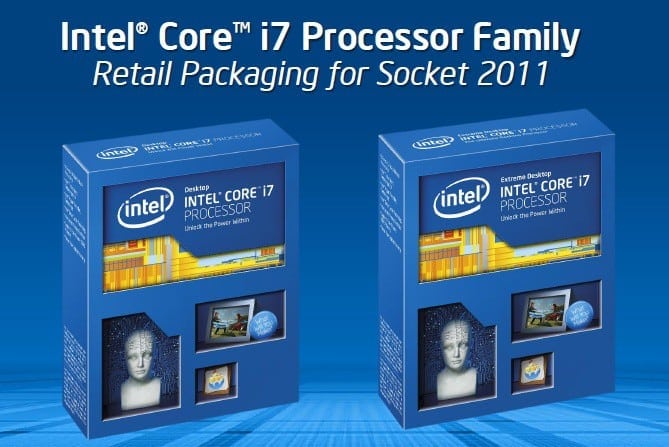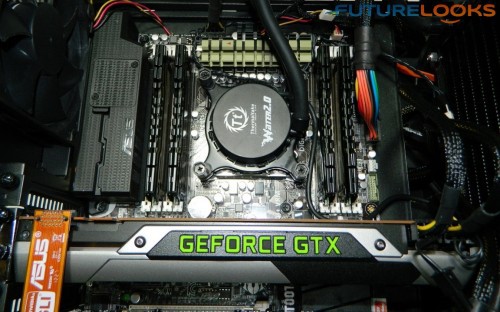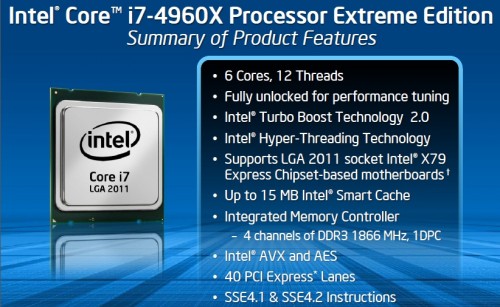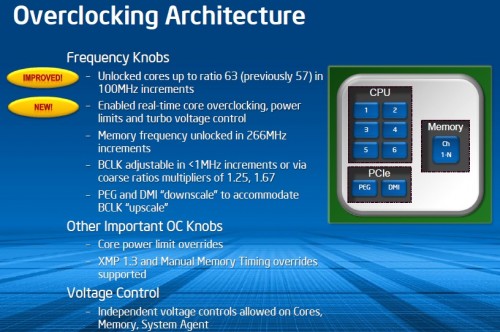It’s been almost two years since the Hexacore Intel Core i7 3960X Sandy Bridge processors launched. In that time, quad core Sandy Bridge parts remained all time favorites amongst enthusiasts due to the gains in performance and overclocking, yet the hex core Sandy Bridge didn’t quite earn the same fanfare. Most end users said that the Core i7-980X Nehalem was just too good a processor to let go of. And then Ivy Bridge (and Haswell) got too hot because it had limited die surface for transferring heat to the heat sink. It seemed that Intel had a bit of a problem with getting more chips out there for the right reasons.
With an Intel Core i7-4960X Extreme Edition (aka Ivy Bridge-E) processor and ASUS X79 Deluxe in hand, we evaluated both component performance characteristics and end user experiences in the lab. Join us for a look at the company’s latest hex core and the latest X79 motherboard technologies.
Intel Core i7-4960X Ivy Bridge Features and Specifications
What makes Ivy Bridge-E (IVB-E) fast? There are three key features: 6 cores with 12 active threads doing all the work, 4 channel integrated memory controller that supports 1866MHz DDR3 standard, and 40 PCI Express lanes which works in unison with any motherboard sporting the X79 chipset including our ASUS X79 Deluxe test board.
As with previous 3rd and 4th Generation processors, the K SKU series processors are the best for overclocking. They may also be built with the best silicone but that’s mainly speculation. Turbo frequencies also reach 4 GHz in this latest revision.
One of the more intersting engineering features is that the PEG and DMI down-scale when the BCLK is increased. Currently, any IVB or Haswell processors can get unstable quick when increasing the BLCK so this can help add a bit more overclocking headroom with less instability.
Another key aspect of IVB-E is that the CPU continues to use the LGA 2011 socket, even though the X79 chipset will receive some key updates. Typically, INTEL will change up the socket with any significant changes, but we are happy that they left well enough alone this time, unlike what they did with Haswell. That’s going to save users some hassles and cash.
Architecturally speaking, the 1.86 Billion transistor count IVB-E processor has better memory overclocking potential. More memory manufacturers have been capable of overclocking their CPU and systems to 3000 MHz versus a very limited, sketchy 2600 MHz on IVB or Haswell.
The Intel Core i7 4960X CPU will hit the shelves at around $1049.99 USD. It will be joined by two more Ivy Bridge-E processors: A less expensive hexacore 4930K at $579.99 US and a quad core 4820K at $329.99 US.
Supported Intel Extreme Edition CPU Coolers
Here is where I start questioning what exactly Intel is doing. Like the Core i7-3960X, the Core i7-4960X does not come with any CPU cooler in the box at all. In fact, the Intel badged Asetek liquid cooler above is actually aftermarket and users will have to purchase it separately. In fact, there aren’t any actual lists of certified coolers.
Considering that this is a 130 Watt TDP processor, I recommend higher end air and liquid CPU coolers. Ones that come to mind immediate are the Noctua NH-D14, which is our standard for testing, and perhaps the Thermaltake Water 2.0 Extreme with its 240mm radiator. Both have passed our rigorous testing and receive our full blessing for larger cooling jobs.
With all the preliminary info out of the way, let’s put together the parts we need to test this processor properly!
Test System
When assembling a test system, I tend to take a more philosophical and practial approach. The CPU is the brain, no arguing that really. But the body, or back bone, of the system is undoubtedly the motherboard. The more intelligent the motherboard, the greater the performance and quality of end user experience. Factors include things such as stability, component support, hardware features, and software.
To more thoroughly break down performance, we’ve pitted Core i7-4960X against some formidable rivals…
Test System 1
- Processor: Core i7-4960X Ivy Bridge-E
- Motherboard: ASUS X79 Sabertooth
- Memory: Kingston HyperX Beast 16GB Quad Channel @ 1866MHz (CAS9)
Test System 2
- Processor: Core i7-3960X Sandy Bridge-E
- Motherboard: Intel DX79SI Extreme
- Memory: Kingston HyperX Genesis 16GB Quad Channel @ 1600MHz (CAS9)
Test System 3
- Processor: Core i7-2600K Sandy Bridge
- Motherboard: ASRock Z68 Extreme 7 Gen 3
- Memory: Kingston HyperX Genesis 4GB Dual Channel @ 1333MHz (CAS9)
Test System 4
- Processor: Core i7-980X Gulftown
- Motherboard: ASUS Rampage III Black Edition (X58)
- Memory: Patriot Memory Division 2 12GB Triple Channel @ 1333MHz (CAS9)
Test System 5
- Processor: AMD FX-8150 Bulldozer
- Motherboard: GIGABYTE GA-990FXA-UD5
- Memory: Patriot Memory Division II 4GB 1866MHz (CAS9)
Shared Components:
- Graphics: 2 x NVIDIA GTX 780 SLI
- Power: Rosewill Tachyon 1000 Watt Platinum
Before using any Ivy Bridge-E processor, users are going to have to update the BIOS on their Intel X79 based motherboards and this will more than likely be everyone if you purchased that board when it first came out. The ASUS Sabertooth X79 needed a quick update which I recommend if you tend to need access to the BIOS. Many of the updates like the ones mentioned in the Z87 Round Up tend to make the BIOS more efficient. Let’s get to testing.
Overclocking Ivy Bridge Extreme – Practice Required
The learning curve for Ivy Bridge Extreme adds a third level of difficulty. With patience and offset voltage (or manual voltage depending on your board), I was able to get the Core i7-4960X up to 4.7GHz before heat was just insanely unmanageable using the Thermaltake Water 2.0 Extreme liquid cooling system. Keep in mind that I’m not using a custom liquid cooling system, but one you can purchase right off the shelf, albeit one of the better ones.
If you need more GHz, you’ll definitely need to invest in triple 120 radiators to get just the CPU to its MAX. Personally, I’m perfectly content with 4.5GHz as it’s just the right sweet spot for performance and stability.
Benchmark Setup
Most of the benchmarks are aimed at testing the CPU only and they include SANDRA, 7-Zip, H.264 Graysky, and CineBench R11.5. However, the CPU influences the PCIE bus too so I followed up with 3DMark 11 and Metro: Last Light. Plus it gave me an excuse to enjoy some games maximum settings, often with NVIDIA 3D Vision 2 on. Let’s get down to it!
SANDRA – Cryptography, Multi-Core Efficiency, Memory Bandwidth, Mathematical and Multimedia.
Multi-core efficiency affects things like bandwidth between the L caches, memory controller, and RAM. Higher latencies are never a good thing. However, 4ms isn’t all that high an increase.
Interestingly, going from 1600MHz to 1866MHz didn’t seem to make any enormous gains. I suspect it has something to do with the slightly higher Multi-core latencies. In nano-seconds, 4ms can translate in to a lot of bandwidth and execution. Since we aren’t really using a lot of desktop apps that need anything more, I’ll take the 34 GB/s.
The increase in GB/s is right on par with the processor change from the Core i7-3960X. Multimedia benefits from the cores and threads as always. In theory, we should see a noticeable improvement in transcoding, or video encoding. We’ll see with the H.264 benchmark results in a minute.
AES256 + SHA2-512 crypto simulation testing shows a bit of an improvement. Professionals who need extra security will be able to encrypt their data a lot faster. To put it in perspective, the hex cores will take about half the time of the quad cores. Definitely worth it if these are the types of workloads you are experiencing.
7 Zip – File Compression
File compression testing reveals there’s some strong processor horsepower still in there. I really wasn’t expecting the 4960X to be this much of an improvement. However, the combination of faster memory and improved architecture make a difference.
Cinebench R11.5
The Core i7-4960X loves the 1866MHz memory. The threads are very helpful in helping the system finally break 12 points without having to overclock massively. This is also a good indicator that the Ivy Bridge-E is going to be a good chip for multimedia fiends or individuals and apps that simply need that many threads.
H.264 GraySky
Well, it’s not a huge leap in transcoding performance. It’s enough to render higher frames especially on the 2nd pass which is generally a lot slower than the first. If you’re converting video, you’ll be quite content with the quicker performance.
3DMark 11 – Testing SLI
Again, we’re using two GTX 780s in SLI which produced a very serious score of 18424 versus a single card’s very respectable 11703 score. Now that we know it rocks the Futuremark title, let’s see what it does maxed out in 3D on Metro: Last Light.
Metro Last Light – Maximum Gaming
I just had to check out Metro: Last Light to see if there’s any extra PCIE performance in the new Ivy Bridge-E architecture. It’s so close that I would pretty much call this a tie. The variances are most likely due to the PCIE controller implementation (if used) and architectural differences found on each motherboard plus additional chipset tuning. Overall, game play is very smooth both by the numbers and in real world play.
Thermal Output
Surprisingly, I recorded the 4960X as being a somewhat cool running processor than its predessors. It was very comparable to the Core i7-980X and Core i7-3960X. Since this is a 130 Watt processor, temps reached an average 56 C with the Thermaltake Water 2.0 Extreme (dual 120mm radiators at 1200 RPMs) between all the cores even though the CPU needs slightly less voltage (VCore). An NZXT HAVIK 140 with dual fans reached 58 C which is about right.
My bottom line recommendation is that you should definitely utilize a high end tower cooler or at least a 120mm liquid cooling system in a push/pull configuration. If you intend to overclock, you’re going to need max fan RPMs on a tower cooler (or a larger one), or any dual 120mm liquid cooling system, with perhaps push/pull fans configured as well.
Final Thoughts – Is the Ivy Bridge-E Extreme?
Summarizing the Intel Core i7-4960X Ivy Bridge Extreme processor is like summarizing the Sandy Bridge Core i7-3960X and Haswell Core i7-4770K in to one thought. While it has a stronger core than Sandy Bridge, the Ivy Bridge and Haswell 22nm processors have very limited contact surface with current CPU coolers. Even though these processors utilize less voltage, there is just enough surface area to transfer heat to the IHS which then travels to the CPU cooler. Thermal physics are limiting overclocks and putting CPU coolers to the test. This is why I recommend utilizing high end proven tower and liquid cooling system coolers to prolong the life of your Ivy Bridge Extreme processor.
That said, the Core i7-4960X processor is a very, very capable hex core, content creation power house. Users will find it very efficient at transcoding media and compiling software. It’s truly meant to do more than game though Intel isn’t going to object to you grabbing one for a super high gaming system. The processor definitely augments NVIDIA SLI nicely whether it be on standard or 3D capable screens. It will definitely feed more extreme triple and quad GPU configurations as well.
The great thing about Ivy Bridge-Extreme is that it’s all about the K-SKUs. Each processor is unlocked which adds more value to each processor meaning there is a very high chance of overclocking. The 4960X starts at $1049.99 US which is about $150-200 more than the 3960X when it launched. And, the 4930K which seems to be the best bang for buck is only $579.99 US, which is comparable to its Sandy Bridge cousin. And, even though the 4820K seems lack luster, remember that it has quad-channel memory support and more PCIE lanes to offer on the X79 chipset. It’s only $329.99 US making a direct competitor to the Core i7 4770K on Haswell.
In the end, I would call the Ivy Bridge-Extreme a standard refresh that will benefit true power users, that will potentially help prolong the investment in your Intel X79 platform as well. And at the top of the performance pyramid, it earns our High Performance Award.
Pros
- 6 Core – 12 Thread computing power
- All kinds of PCIE Lane bandwidth support
- Quad channel 1866MHz DDR3 support
- Fastest CPU on the market
- Costs slightly less for power users this time
Cons
- Costs the usual premium
- Limited thermal transfer surface and slightly hotter than previous generation
- Limited chipset refresh support
Overall Rating: 8.5 / 10.0
Help Us Improve Our Reviews By Leaving a Comment Below!




